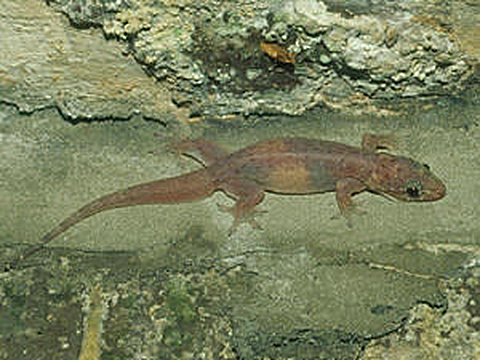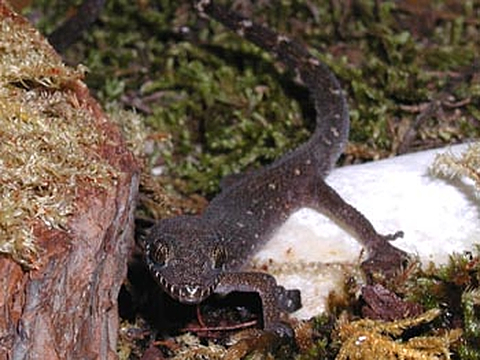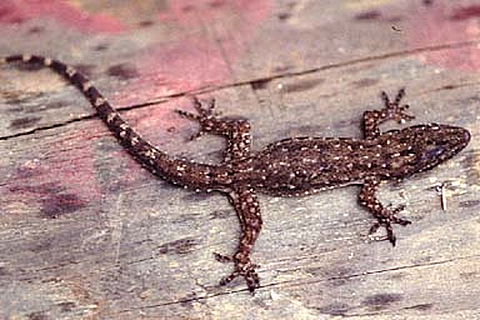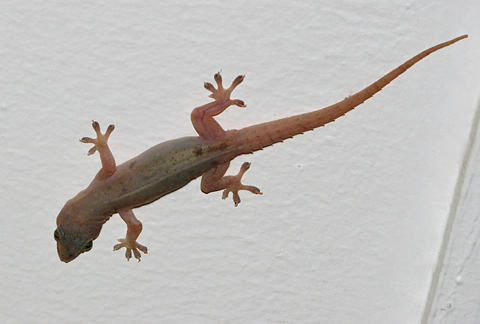Birds and Plants of Kauai:
The Gecko
by Linda Pascatore on 26 June 2008
The gecko is a common sight in Hawaii. They inhabit our gardens and share our homes. Although no geckos are native species on Hawaii, some were here centuries before Western contact. They either came with the early Polynesian settlers as stowaways on the voyaging canoes, or their salt water resistant eggs floated here on logs or other debris.
It is thought that the Morning Gecko, the Stump-Toed Gecko, the Small Tree Gecko, and the Fox Gecko all may have been long time Hawaiian residents. More recently, other species have arrived as aliens. These include the Common House Gecko on all Hawaiian islands, and Tokay, Orange Spotted Day, Gold Dust Day, and Giant Day Geckos which are found only on Oahu.
All of the early Hawaiian gecko species are parthenogenic. This means that there are only females of those species. They lay eggs which are ready to hatch without any male required to fertilize them. Their eggs are small, white, and round, and tend to adhere to the surface where they are laid. Their eyes have a vertical pupils and are without lids. These species are mostly nocturnal, or active at night.
They all have special toepads with thousands of tiny spatula tipped setae which allow them to climb walls and hang from the ceiling. The setae use van der Waals interactions (the attractive forces between molecules) to hold them to various surfaces. The only surface that a gecko will not stick to is Teflon, although the holding power is reduced on wet or rough surfaces.
Most homes in Hawaii welcome geckos, because they eat insects like ants, mosquitos and roaches. Geckos are very vocal creatures. They make a clicking sound that sounds almost like a person saying, “Tsk, tsk, tsk”, which can be heard at night. They also make repeated chirping sounds at times. Another sound heard is the tapping as the gecko holds its prey in its mouth and hits it against the wall, window, or ceiling to kill it. Here in Hawaii, the occasional
gecko poop, eggs found stuck inside printers, and strange night sounds are all well worth the service the gecko performs by eating household insects. Geckos also eat fruit, nectar, and pollen. They will lick up juice with their long tongues.
Here in Hanapepe Valley on Kauai, we often observe Geckos at night standing on the outside of our window panes. They hunt bugs here, and we witness many battles. We can also see the eggs of pregnant geckos showing through their translucent bellies, which is quite an amazing sight.
In Hawaiian Mythology, the gecko represented a smaller incarnation of the Mo’o, the giant magical lizard. The mo’o was an aumakau, an animal spirit that is tied to certain families. Both the mo’o and the gecko were guardian spirits, who protected the Hawaiian people.
 Mourning Gecko: Lepidodactylus lugubris Mourning Gecko: Lepidodactylus lugubris
The Mourning Gecko is also called the Common Smooth Scaled Gecko. It is a creamy color with darker brown zigzag pattern overlaid. The underside is beige and sometimes speckled. It is a smaller gecko, and grows to only about 3 inches in length. The skin on its back is smooth, and lacks tubercles, or spiny scales found on some other species. It has a dark line between the eyes and down to the neck. It is stouter than the Indopacific species, and has claws on all its toes.
The Mourning Gecko is found throughout the Hawaiian Islands, and the rest of the Pacific, including New Zealand and Australia,; as well as in South and Central America. It was the most prominent species of gecko in the Hawaiian Islands before the introduction of the Common House Gecko around the time of World War II. Since the competition from the more aggressive House Gecko, the populations of Mourning Geckos and other older Hawaiian species have been declining.
 Stump Toed Gecko: Gehyra mutilata Stump Toed Gecko: Gehyra mutilata
The Stump Toed Gecko is also called the four clawed gecko, because only four of its five toes have claws. This gecko has a translucent quality. It is light gray or brown during the day, and more whitish at night. It has darker spots, and a pinched ring at the base of the tail. There are light rings around the tail, and no spine. The adults grow to about 4 inches long.
This is found throughout Hawaii and the Pacific, as well as in Southeast Asia, Indonesia, and Mexico. It has an interesting defense mechanism. When grabbed, it twists violently, and patches of it’s skin come loose. This usually startles the predator, which then lets it go. This gecko is found in both urban rural areas; in trees, bushes and walls.

Small Tree Gecko: Hemiphyllodactylus typus
The Small Tree Gecko is also called the Indopacific Tree Gecko or Common Dwarf Gecko. It has a long thin nose and a flattened tail. It’s body is translucent, and covered with tiny granular scales. It does not have the warty tubercles and spines which some other gecko species have, and is also less vocal. In daylight hours, it is usually gray or brown, with a pattern of light and dark markings, and the tail has an orange underside. There are white flecks and black
markings on the back, and a thin black line from the nose through the eye and across the neck and shoulder. At night, this gecko will change to a pale, whitish color.
Small Tree Geckos have a rudimentary inner toe on the forefoot, which does not have a claw. These are the small and slender, with short legs. They grow to only about 3 inches in length and are the smallest of the older Hawaiian species. They are found on all the Hawaiian islands, in South Asia and through islands in the Indian Ocean.
This gecko is not found in urban areas, but in rural valleys and forested areas. They prefer undeveloped, undisturbed areas and are solitary, so are more rarely seen than other species. They hunt at night in trees, on small insects and spiders. During the day they hide behind loose bark or protected locations, where they also lay pairs of eggs.
Small Tree Geckos are threatened by loss of forest habitat, as well as competition from introduced species.

Fox Gecko: Hemidactylus garnotii
This gecko is also called the Indopacific Gecko, or Garnot’s House Gecko. The nickname Fox Gecko comes from the long, narrow snout. It has a flattened tail with a row of spiny scales on the lateral edges. In the daytime, it is dark gray or brown with markings, and at night it is a pale, translucent color. The belly is orange or yellow. Adults are about 4 or 5 inches long.
This species is found in India, the Philippines, Southeast Asia, and Australia, as well as throughout Polynesia. It was once considered a house gecko, living in and around homes, but more recently has been displaced to more natural settings by the newer arrival, the Common House Gecko.

The Invader: Common House Gecko: Hemidactylus frenatus
Since this is the species that has threatened the older species on Kauai, we will also describe it here. The Common House Gecko arrived in the Hawaiian islands around the time of World War II. They are now the most common species here, not just in urban areas, but also in forested areas. They have largely displaced the Mourning and Stump-Toed Geckos.
The Common House Gecko is a grayish white color. It’s back has tiny black spots or markings. It does not have tubercles or spines on its back, but its tail is ringed with rows of spines. It grows to 4 or 5 inches.
These geckos are not parthenogenic, but have males and females of the species. The males are quite territorial, and may explain why they have displaced the older female only species that arrived earlier in Hawaii. The Common House Gecko will also eat juvenile geckos of its own and other species.
For more about geckos visit www.geckoweb.org |


 Mourning Gecko: Lepidodactylus lugubris
Mourning Gecko: Lepidodactylus lugubris Stump Toed Gecko: Gehyra mutilata
Stump Toed Gecko: Gehyra mutilata

